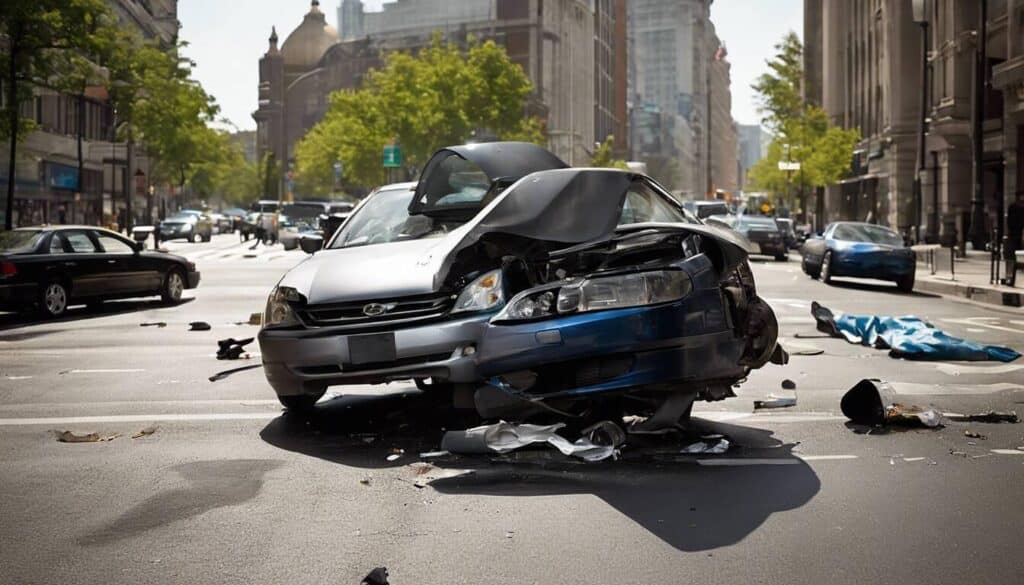In a car accident case, negligence refers to the failure to behave with reasonable care while driving, which can lead to liability if it causes injury or damage. It’s essential to prove the other driver’s negligence to hold them legally responsible for compensating the injured party. If you have been injured in a car accident due to another driver’s negligence, you may be entitled to compensation for medical expenses, lost income, and pain and suffering.
Car Accident Negligence: Key Aspects
Negligence isn’t just an abstract idea. It’s at the core of personal injury law, especially in car accidents. Simply put, negligence means failing to take reasonable care while driving and subsequently causing harm to others. But what is “reasonable care”? Let’s think about it like this: Imagine driving a car as if you were handling a precious and delicate package. You’d need to be cautious, alert, and considerate of others. Failure to do so might result in damage or injury—unlike treating the situation with care.
Proving negligence requires establishing four elements:
- Duty: The other driver owed you a duty of care while on the road.
- Breach: The other driver failed to uphold their duty of care.
- Causation: Their negligence directly caused the car accident.
- Damages: You suffered actual damages or injuries due to the accident resulting from their negligence.
For example, if a driver was texting while driving and caused a rear end collision, they failed in their duty by not focusing on the road (the breach). The accident was directly caused by this negligence (causation), and you sustained injuries because of the accident (damages).
In the legal world, it’s essential to remember one key phrase: “He who alleges must prove.” This means that the injured party must provide sufficient evidence that the other driver was negligent, breaching their duty of care.
Witness statements, police reports, photographs of the accident scene, and even traffic camera footage are valuable pieces of evidence that help demonstrate negligence.
Understanding these pivotal aspects of car accident negligence paves the way for establishing fault, determining liability, and seeking compensation for physical, emotional, and financial damages incurred as a result of someone’s negligent actions while driving.
Identifying the Party at Fault
When establishing who was at fault in a car accident, there are key factors and evidence that help bring clarity to the situation.
Contributing Factors
Speeding, failing to yield, distracted driving, running red lights, or driving under the influence are all contributing factors that can point to fault in a car accident. For instance, if one driver failed to yield while entering an intersection and crashed into another vehicle, they would likely be deemed at fault. A careful evaluation of each driver’s actions helps determine where negligence lies. The same holds true for accidents caused by speeding or driving under the influence—these actions are clear evidence of negligence which can lead to establishing fault.
Gathering Evidence
The process of gathering evidence is crucial when it comes to determining fault. Witness statements, police reports, photographic proof, and any other evidence from the accident scene can paint a clear picture of what happened.
Imagine there’s a car crash at an intersection and you were not at fault. You could have witnesses that saw everything and can tell the authorities how the other driver was on their phone and didn’t notice the red light, clearly indicating that they were at fault. Moreover, photographic evidence—whether taken on-site or soon after the collision—can capture important details like skid marks or intersections in ways that can be lost in time.
By considering all these steps carefully, you’ll be better prepared to identify who is at fault in a car accident and protect your rights accordingly.
Role of Insurance in Setting Fault
When you’re involved in a car accident, insurance companies play a pivotal role in determining who is at fault. Each side’s insurance company appoints claims adjusters to carefully examine every aspect of the accident to establish liability.
These claims adjusters have the challenging task of investigating and gathering evidence to pinpoint the negligent party. They analyze police reports, witness testimonies, and any available photographic evidence to piece together a comprehensive understanding of the accident. Their ultimate goal is to assign responsibility for causing the accident based on their findings.
Insurance companies apply various tactics to mitigate their financial responsibility in paying out claims. For instance, they might try to place some or all of the blame on you, ultimately reducing their financial obligation.
Understanding this investigative process is crucial as it can help you prepare for discussions with insurance adjusters. It also underscores the need for precise documentation and gathering substantial evidence to support your case.
It’s important to note that Idaho follows comparative negligence laws when determining fault in an accident. This means that more than one party can share fault for an accident, and the percentage of liability will be apportioned accordingly.
In simpler terms, this indicates that even if you were partly responsible for the accident, you can still recover damages. However, your compensation will correspondingly reduce based on your share of fault. Understanding these rights and responsibilities under comparative negligence laws in Idaho is paramount.
For example, if another driver runs a red light and hits your car, but you were exceeding the speed limit at the time, both drivers could share liability for the collision — you for speeding and the other driver for disregarding the traffic signal. In such a case, if your total damages amount to $10,000 and you are found 20% at fault, your recovered damages will reduce by 20%, leaving you with $8,000 instead of the full $10,000.
This principle underscores the importance of obtaining legal advice from professionals experienced in handling car accident cases efficiently. An adept attorney can help interpret these complex laws vis-a-vis your case circumstances and secure maximum compensation on your behalf.
By recognizing the impact of insurance investigations and comprehending Idaho’s comparative negligence laws, you’ll be better equipped to navigate potential challenges associated with proving fault and securing due compensation after a car accident.
Understanding these critical aspects of fault determination sets the stage for our next dive into deciphering liability in car accident injuries.
Process of Seeking Compensation for Damages
The aftermath of a car accident can be overwhelming and distressing. Amid the chaos, it’s crucial to consider your legal rights to pursue compensation for the damages incurred due to another party’s negligence. Seeking compensation involves understanding both economic and non-economic damages that you may be entitled to recover.
Economic Damages: These are tangible, measurable losses resulting from the accident:
| Aspect | Explanation |
| Medical Expenses | Costs of all reasonable and necessary medical treatment, including hospital stays, surgeries, medication, physical therapy, and assistive devices. |
| Property Damage | Vehicle repairs or replacement and any other personal property damaged during the accident. |
| Lost Wages | Income lost due to inability to attend work as a result of injuries sustained in the accident. |
Realizing the full extent of economic losses is essential for ensuring comprehensive compensation for all financial repercussions stemming from the accident.
For instance, imagine being unable to attend work following an accident due to debilitating injuries. Then facing mounting medical bills and worrying about making ends meet without a paycheck. Seeking compensation aims to alleviate these burdens by holding the negligent party accountable for providing financial relief.
Non-Economic Damages: While economic damages address the tangible impact of an accident, non-economic damages pertain to the emotional and psychological toll on well-being:
- Pain and Suffering: Physical pain endured as a result of injuries sustained in the accident, along with ongoing discomfort caused by those injuries.
- Emotional Distress: Trauma, anxiety, insomnia, or depression experienced due to the accident.
It’s important to recognize the genuine toll these intangible consequences have had on life and seek appropriate compensation for them.
As you navigate this complex process, it’s vital to consult with experienced legal counsel who can comprehensively evaluate your case and ensure that all viable areas of compensation are pursued.
Pursuing compensation for both economic and non-economic damages following a car accident isn’t just about recovering monetary losses; it’s about restoring stability and peace of mind after a traumatic event.

